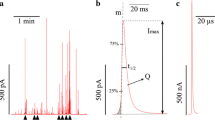Summary
Electric field pulses (in the 5 to 25 kV/cm range) were found to cause a transient increase in the intensity of scattered light (wavelength=369 nm, scattering angle=90°) from aqueous sucrose suspensions of chromaffin granules. Similar observations were made with the membranes of osmotically lysed chromaffin granules. Under the same experimental conditions the degree of polarization of the scattered light changed only very slightly. The fluorescence of the hydrophobic probe diphenyl-hexatriene, incorporated into the membrane of intact chromaffin granules, showed similar transient changes in the intensity. The calculated relaxation times for these changes in optical properties were approximately 150 μsec for the rising phase, and approximately 1 msec for the early stage of the decay. A further relaxation time of about 30 msec was also observed by using this probe. Essentially, all of these signals originated from the granule membrane, and could be attributed to rather small changes in particle size, membrane thickness or refractive index. Moreover, these signals were found to be completely reversible. Catecholamine release from intact granules, pulsed at voltages of 25 kV/cm, occurs already during the first few milliseconds of the transient membrane change.
Similar content being viewed by others
References
Blaschko, H., Firemark, H., Smith, A. D., Winkler, H. 1967. Lipids of the adrenal medulla: Lysolecithin, a characteristic constituent of chromaffin granules.Biochem. J. 104:545
Duysens, L. N. M. 1956. The flattening of the absorption spectrum of suspensions as compared to that of solutions.Biochim. Biophys. Acta 19:1
Heilmeier, G. H., Zanoni, L. A., Barton, L. A. 1968. Dynamic scattering: A new electrooptic effect in certain classes of nematic liquid crystals.Proc. IEEE. 56:1162
Helle, K. B., Flatmark, T., Serck-Hanssen, G., Lönning, S. 1971. An improved method for the large-scale isolation of chromaffin granules from bovine adrenal medulla.Biochim. Biophys. Acta 226:1
Kerker, M. 1969. The Scattering of Light and Other Electromagnetic Radiation. Chap. 5. Academic Press, New York-London
Latimer, P., Moore, D. M., Bryant, F. D. 1968. Changes in total light scattering and absorption caused by changes in particle conformation.J. Theoret. Biol. 21:348
Neumann, E., Rosenheck, K. 1972. Permeability changes induced by electric impulses in vesicular membranes.J. Membrane Biol. 10:279
Rigler, R., Rabl, C. R., Jovin, T. M. 1974. A temperature-jump apparatus for fluorescence measurements.Rev. Sci. Instrum. 45:580
Rosenheck, K., Schneider, A. S. 1973. Circular dichroism of chromaffin granule proteinsin situ: Analysis of turbidity effects and protein conformation.Proc. Nat. Acad. Sci. 70:3458
Trifaro, J. M., Dworkind, J. 1970. A new and simple method for isolation of adrenal chromaffin granules by means of an isotonic density gradient.Analyt. Biochem. 34:403
Winkler, H. 1971. The membrane of the chromaffin granule.Phil. Trans. 261:293
Winkler, H., Strieder, N., Ziegler, E. 1967. Über Lipide, insbesondere Lysolecithin in den chromaffinen Granula verschiedener Species.Arch. Pharmak. Exp. Path. 256:407
Author information
Authors and Affiliations
Rights and permissions
About this article
Cite this article
Rosenheck, K., Lindner, P. & Pecht, I. Effect of electric fields on light-scattering and fluorescence of chromaffin granules. J. Membrain Biol. 20, 1–12 (1975). https://doi.org/10.1007/BF01870624
Received:
Issue Date:
DOI: https://doi.org/10.1007/BF01870624




